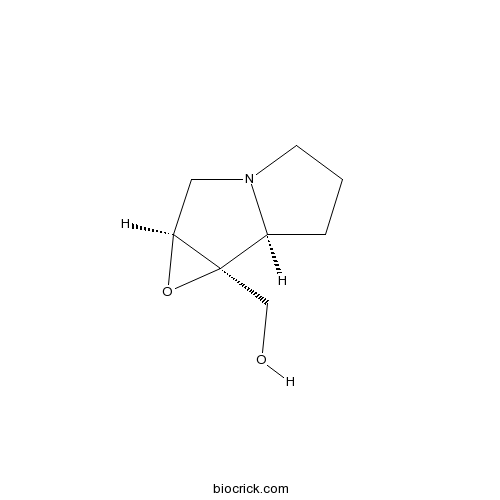1,2-Epoxy-1-hydroxymethylpyrrolizidineCAS# 15211-03-7 |

Quality Control & MSDS
3D structure
Package In Stock
Number of papers citing our products

| Cas No. | 15211-03-7 | SDF | Download SDF |
| PubChem ID | 14110209 | Appearance | Powder |
| Formula | C8H13NO2 | M.Wt | 155.20 |
| Type of Compound | Alkaloids | Storage | Desiccate at -20°C |
| Solubility | Soluble in Chloroform,Dichloromethane,Ethyl Acetate,DMSO,Acetone,etc. | ||
| SMILES | C1CC2C3(C(O3)CN2C1)CO | ||
| Standard InChIKey | FRPJEHRSJNAWEI-BIIVOSGPSA-N | ||
| General tips | For obtaining a higher solubility , please warm the tube at 37 ℃ and shake it in the ultrasonic bath for a while.Stock solution can be stored below -20℃ for several months. We recommend that you prepare and use the solution on the same day. However, if the test schedule requires, the stock solutions can be prepared in advance, and the stock solution must be sealed and stored below -20℃. In general, the stock solution can be kept for several months. Before use, we recommend that you leave the vial at room temperature for at least an hour before opening it. |
||
| About Packaging | 1. The packaging of the product may be reversed during transportation, cause the high purity compounds to adhere to the neck or cap of the vial.Take the vail out of its packaging and shake gently until the compounds fall to the bottom of the vial. 2. For liquid products, please centrifuge at 500xg to gather the liquid to the bottom of the vial. 3. Try to avoid loss or contamination during the experiment. |
||
| Shipping Condition | Packaging according to customer requirements(5mg, 10mg, 20mg and more). Ship via FedEx, DHL, UPS, EMS or other couriers with RT, or blue ice upon request. | ||
| In vitro | Evidence for arginine as the endogenous precursor of necines in heliotropium.[Pubmed: 16665402]Plant Physiol. 1987 May;84(1):42-6.
|

1,2-Epoxy-1-hydroxymethylpyrrolizidine Dilution Calculator

1,2-Epoxy-1-hydroxymethylpyrrolizidine Molarity Calculator
| 1 mg | 5 mg | 10 mg | 20 mg | 25 mg | |
| 1 mM | 6.4433 mL | 32.2165 mL | 64.433 mL | 128.866 mL | 161.0825 mL |
| 5 mM | 1.2887 mL | 6.4433 mL | 12.8866 mL | 25.7732 mL | 32.2165 mL |
| 10 mM | 0.6443 mL | 3.2216 mL | 6.4433 mL | 12.8866 mL | 16.1082 mL |
| 50 mM | 0.1289 mL | 0.6443 mL | 1.2887 mL | 2.5773 mL | 3.2216 mL |
| 100 mM | 0.0644 mL | 0.3222 mL | 0.6443 mL | 1.2887 mL | 1.6108 mL |
| * Note: If you are in the process of experiment, it's necessary to make the dilution ratios of the samples. The dilution data above is only for reference. Normally, it's can get a better solubility within lower of Concentrations. | |||||

Calcutta University

University of Minnesota

University of Maryland School of Medicine

University of Illinois at Chicago

The Ohio State University

University of Zurich

Harvard University

Colorado State University

Auburn University

Yale University

Worcester Polytechnic Institute

Washington State University

Stanford University

University of Leipzig

Universidade da Beira Interior

The Institute of Cancer Research

Heidelberg University

University of Amsterdam

University of Auckland

TsingHua University

The University of Michigan

Miami University

DRURY University

Jilin University

Fudan University

Wuhan University

Sun Yat-sen University

Universite de Paris

Deemed University

Auckland University

The University of Tokyo

Korea University
- 3,4-Dimethoxybenzamide
Catalog No.:BCN6565
CAS No.:1521-41-1
- Dp44mT
Catalog No.:BCC6518
CAS No.:152095-12-0
- Epothilone B (EPO906, Patupilone)
Catalog No.:BCC1092
CAS No.:152044-54-7
- Epothilone A
Catalog No.:BCC1091
CAS No.:152044-53-6
- Sophoricoside
Catalog No.:BCN2294
CAS No.:152-95-4
- Vicine
Catalog No.:BCC8366
CAS No.:152-93-2
- Quinestrol
Catalog No.:BCC9132
CAS No.:152-43-2
- Verapamil HCl
Catalog No.:BCC4747
CAS No.:152-11-4
- Ac2-26
Catalog No.:BCC5825
CAS No.:151988-33-9
- 6- Methoxydihydrosanguinarine
Catalog No.:BCN8346
CAS No.:151890-26-5
- 2-Phenylmelatonin
Catalog No.:BCC6748
CAS No.:151889-03-1
- Kinsenoside
Catalog No.:BCN3858
CAS No.:151870-74-5
- Teuclatriol
Catalog No.:BCN1676
CAS No.:152110-17-3
- 2-chloro-11-cyclopentyl-5H-benzo[e]pyrimido[5,4-b][1,4]diazepin-6(11H)-one
Catalog No.:BCC8568
CAS No.:1521197-43-2
- N,N'-Di-Boc-1H-pyrazole-1-carboxamidine
Catalog No.:BCC9065
CAS No.:152120-54-2
- SB202190 (FHPI)
Catalog No.:BCC1093
CAS No.:152121-30-7
- SB 203580
Catalog No.:BCC3663
CAS No.:152121-47-6
- PD 169316
Catalog No.:BCC3969
CAS No.:152121-53-4
- A 80426 mesylate
Catalog No.:BCC7336
CAS No.:152148-64-6
- Forrestin A
Catalog No.:BCN1677
CAS No.:152175-76-3
- Aphadilactone B
Catalog No.:BCN7646
CAS No.:1522004-68-7
- Aphadilactone C
Catalog No.:BCN7645
CAS No.:1522004-70-1
- SB 204741
Catalog No.:BCC7035
CAS No.:152239-46-8
- GT 2016
Catalog No.:BCC7357
CAS No.:152241-24-2
Evidence for arginine as the endogenous precursor of necines in heliotropium.[Pubmed:16665402]
Plant Physiol. 1987 May;84(1):42-6.
In pyrrolizidine alkaloid-bearing Heliotropium angiospermum and H. indicum shoots exposed, in the light, to (14)C-labeled CO(2) for 44 hours, the incorporation of (14)C into 1,2-Epoxy-1-hydroxymethylpyrrolizidine and retronecine amounted to 0.23 and 0.15%, respectively, of the total carbon assimilated. Treatment of the shoots with alpha-dl-difluoromethylornithine, the specific ornithine decarboxylase inhibitor, at 1 to 2 millimolar had no effect on (14)C incorporation into the necines. In contrast, alpha-dl-difluoromethylarginine, the specific arginine decarboxylase inhibitor, prevented the incorporation of (14)C into the necines of both species; the inhibitor did not affect the absolute incorporation of (14)C from exogenous [1,4-(14)C] putrescine in either species. Thus, arginine is the only apparent endogenous precursor of the putrescine channeled into pyrrolizidines, at least in these two Heliotropium species that exhibited a relatively much higher in vitro activity of arginine decarboxylase than of ornithine decarboxylase. However, within 28 hours after administration, not only exogenous l-[5-(14)C]arginine, but also exogenous l-[5-(14)C]ornithine exhibited significant incorporation of their label into the necines, incorporation that could be partially prevented by both inhibitors. Neither inhibitor affected the rates of (14)C-labeled CO(2) assimilation, transformation of labeled assimilates into ethanol-insoluble compounds, or the very high degree of conversion of the introduced amino acids into other compounds. Methodology related to alkaloid biosynthetic studies is discussed.


